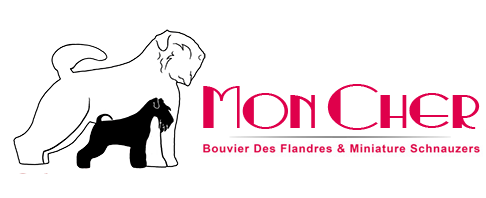In this section, I provide simple advice and links to the various most commonly found health problems. Hopefully, you won’t meet with too many of these throughout your dog’s lifetime, but sometimes despite best efforts by owner and breeder, they will crop up. Mother Nature can never be predicted or directed so our best defense is to be well educated in recognising and treating any problems quickly and effectively.
Bloat / GDV
This is a life-threatening emergency condition and every second counts. The quicker you can reach your vet’s operating table, the better your dog’s chance of survival. Symptoms are very obvious –
- Obviously swelling stomach
- excess Drooling
- attempting to vomit (often without success)
- Heavy breathing
- Groaning
Large, deep-chested dogs seem to be particularly vulnerable to the condition. Bitches being spayed, a gastroplexi procedure (fixing the stomach so it cannot move or twist) can be performed in tandem with the spay. Dividing meals into 2 or 3 smaller meals per day and taking care not to over-do exercise after meals can all help prevent GDV.
Sebaceous Cysts
These are painless and normally benign lumps under the skin. They can be identified by their contained feel and moveability – you should be able to get your fingers around them. Worth having checked by a vet who will most probably advise they are left well alone and simply monitored. Providing they are not interfering with the dog’s comfortable movement or area where a collar may sit. Occasionally they burst when good hygiene and a check-up at the vets is advisable to ensure the cyst has fully drained and doesn’t become infected.
Hypothyroidism
A common condition in larger breeds and once diagnosed, relatively easy to manage with a daily tablet. It can severely affect fertility in bitches and this is often what leads to the initial diagnosis. The telltale signs of Hypothyroidism are firstly palm-sized oval, symmetrical bald patches on the dog’s flanks. As the condition progresses there is general lethargy, weight gain, deterioration & thinning of the coat, skin flakiness and sometimes itching. A trip to the vets and some work to balance the correct dose of Levothyroxine usually see’s rapid improvements in a short time. I like to feed Seaweed/Kelp to all my dogs as this provides iodine which is essential to Thyroid function.
Pancreatitis
A very unpleasant and painful condition that can occur spontaneously. Easily identified by a dogs very obvious discomfort, vomiting / diarrhoea and lying in a typical “praying position” in an attempt to relieve the stomach pain. An emergency Vet appointment is a must and the faster this condition receives treatment, the quicker and more successful the outcome. If left untreated it can cause irreparable damage to other organs.
A very low fat diet ( under 5% fat) is recommended for dogs prone to this condition.
Hormone Related Incontinence
This problem is almost always due to bitches being spayed / neutered at a very young age. A previously housetrained bitch begins to have inexplicable “accidents” and dribbles urine in her sleep. Although manageable with daily meds, it is a very good example of why waiting until any dog reaches full maturity before neutering, is ALWAYS the best choice.
Benign Prostatic Hyperplasia
A common condition in young intact males. On vet examination, many males will have a slightly enlarged prostate, and this is typically not a problem. However, when the prostate enlarges significantly it can press on the bowel causing a dog a great deal of discomfort. Vets can be very quick to recommend castration as the only solution but there are successful medications and simple dietary changes which will very successfully treat and control the condition. Do NOT be rushed into castrating your male, there are very good alternatives!
Cataracts
There are 3 types of cataracts –
- Congenital
- Hereditary
- Age-related
The first 2 are those which dogs are either born with or develop in the first few years of life. They are both considered to be hereditary, particularly in Schnauzers. All Schnauzers litters should be screened by an Ophthalmic Specialist between 6 and 8 weeks of age under the BVA Eye Scheme
Adult Schnauzers are screened annually under the same scheme.
Bouviers have no formal requirement for eye screening but some breeders chose to do this voluntarily with their adults prior to breeding.
Glaucoma
This is a very painful eye condition, often leading to loss of the affected eye. It is recognised in Bouviers, however in the UK and Europe considered rare. It can develop as a secondary condition to Diabetes.
There is a BVA Eye Screen test (Goinioscopy) which can be performed, measuring the drainage angles of the eye. Sadly this test applies only to the day it is performed. Dogs with closed angles (high risk) often never develop the condition, and Dogs with open angles (desirable) can subsequently develop Glaucoma. There is no formal requirement for Goinioscopy in Bouviers and breeders may or may not chose to do it voluntarily.
Dilated Cardiomyopathy (DCM)
A very sad heart condition seen in large breeds. Dobermans seem to be particularly vulnerable, but in any breed, it is life-shortening and incurable. It usually develops in middle age to old age dogs and much more prevalent in males than females. The heart muscles become weakened and “floppy,” progressively losing the ability to pump blood around the body.
The worst aspect of the disease is the absence of any health scheme or test to identify a dog who will develop the condition. So breeders are helpless to eradicate the condition and only become aware of a problem many years too late.
There is a suggestion that dietary deficiencies of Taurine and Carnitine (essential amino acids found largely in red meat) can cause congestive heart diseases. So careful provision of a balanced healthy diet high in the appropriate meat products may be preventative.
Joint Problems and Conditions
There are several well recognised Joint Conditions affecting large breeds and these are generally grouped under the Umbrella Terms of “Hip Dysplasia” and “Elbow Dysplasia”. Neither of these terms are a condition themselves but describe various degenerative bone conditions triggered by trauma, environment, diet, climate, exercise, and genetics.
In Humans, Dysplasia in its truest form is present from Birth
In Dogs the science has evolved more slowly and Joint Health assessment is only possible from 12 months of age. At this point, the BVA Hip and Elbow Scoring scheme are relied upon to read and evaluate X-Rays. Although reassuring for a breeder to ensure a dog’s joint structure is acceptable, the Hip and Elbow Scoring Scheme is limited in its ability to give reason or diagnosis. A score can range from 0 – 53 per Hip (0 = Perfect, 53 = severely affected).
The reason for this very late X-ray assessment is because Puppies are born with complete joint structures entirely composed of cartilage, this being invisible to X-Ray techniques. Bone begins to form in these Cartilage joints and continues to develop and mature until a large breed dog is around 18 months of age.
Many factors can be responsible for disruption to normal joint development and Environmental factors are significant.
Irrespective of Parents healthy Joints / Hip & Elbow Scores, and the Breeders attention to excellent rearing and diet, the following can be catastrophic to a puppies joints in its first 12 months –
- Excess Exercise before 12 months (Biking, Jogging, Treadmill)
- Rough Play (with larger dogs, excited children, rough and tumble)
- Jumping from height (The car, grooming table, sofa)
- Stairs
- Slippery Floor surfaces
- Long Walks (Pounding the pavements)
- A sudden change of Diet
- Unexplained lameness if left untreated (Every Limp is significant and MUST be rested)
- Overfeeding ( a fat puppy puts an unhealthy strain on joints)
- Excessive protein and artificially fast growth (distorts healthy bone and joint development
- Early Spaying and Neutering (devastating to growing bones, joints and growth plates)
- Extremes of temperature (affecting circulation and blood supply to joints)
Finally, there is also understood to be a Polygenic factor which in itself is proving difficult to identify or develop a Genetic or DNA test for. The BVA Scoring Schemes are our only current method of finding and recording generational Joint Health information.
Thankfully with modern Ultrasound technologies, it is now possible to evaluate a puppy’s joints and development from around 6 weeks of age. This can quickly identify peculiarities or damage and even permit the successful treatment of conditions before they become chronic and life-limiting.
PupScan Project
Given the Ultrasound confirmation of Normal Joint development in a puppy leaving home, and with the dedication to very careful management for the puppy’s first 12 months, there is good reason (disaster excepted) to anticipate a Bouvier puppy growing up skeletally sound and healthy.







